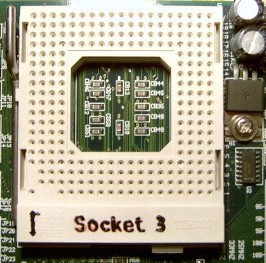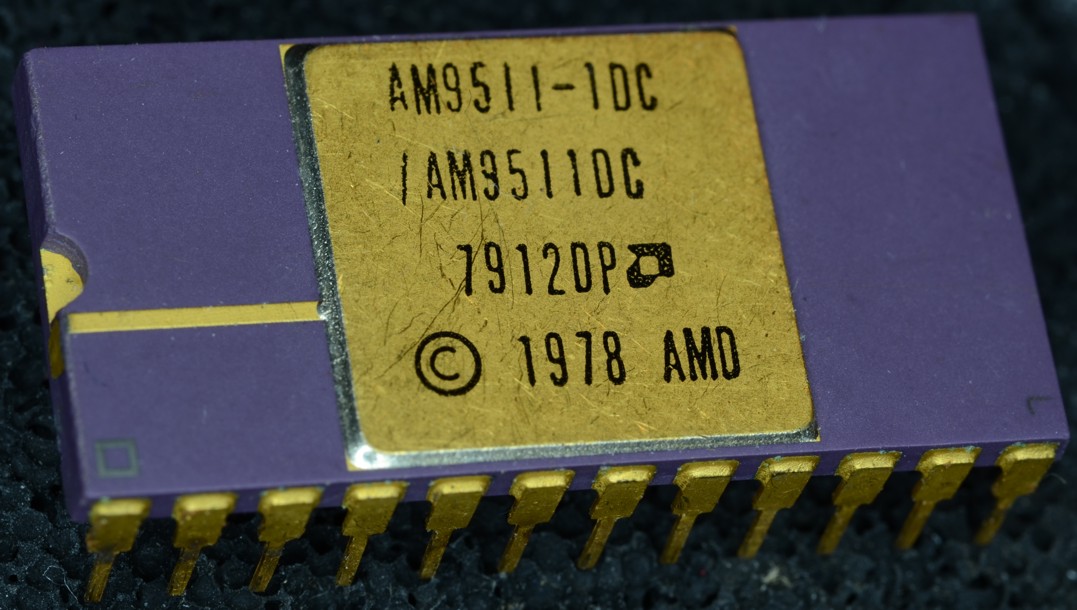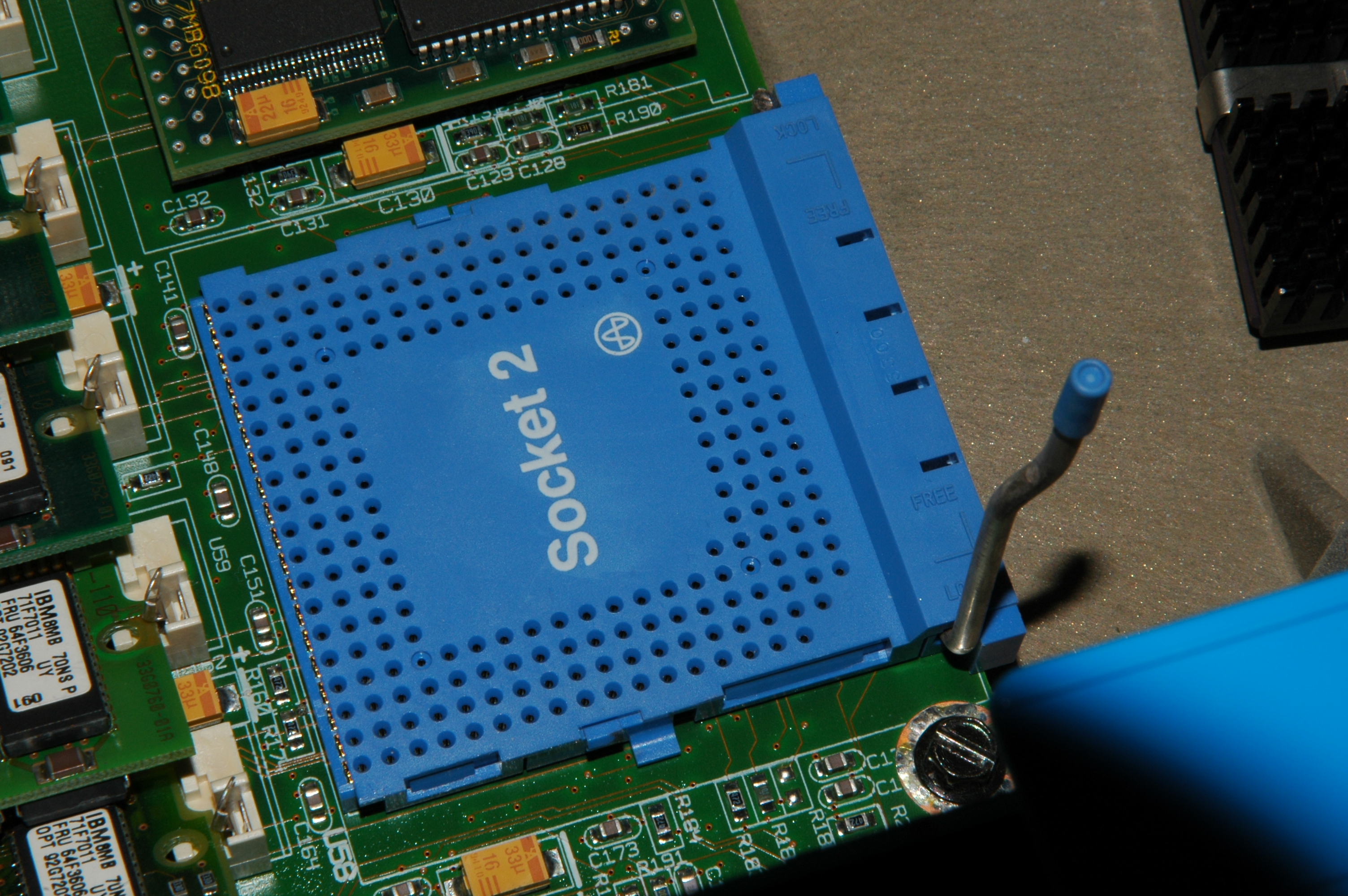|
Socket 3
Socket 3 was a series of CPU sockets for various x86 microprocessors. It was sometimes found alongside a secondary socket designed for a math coprocessor chip, such as the 487. Socket 3 resulted from Intel's creation of lower voltage microprocessors. An upgrade to Socket 2, it rearranged the pin layout. Socket 3 is compatible with 168-pin socket CPUs. Socket 3 was a 237-pin low insertion force (LIF) or zero insertion force (ZIF) 19×19 pin grid array (PGA) socket suitable for the 3.3 V and 5 V, 25–50 MHz Intel 486 SX, 486 DX, 486 DX2, 486 DX4, 486 OverDrive and Pentium OverDrive processors as well as AMD Am486, Am5x86 and Cyrix Cx5x86 processors. See also * List of Intel microprocessors * List of AMD microprocessors This article gives a list of AMD microprocessors, sorted by generation and release year. If applicable and openly known, the designation(s) of each processor's core (versions) is (are) listed in parentheses. For an overview over concrete prod ... [...More Info...] [...Related Items...] OR: [Wikipedia] [Google] [Baidu] |
Socket 3
Socket 3 was a series of CPU sockets for various x86 microprocessors. It was sometimes found alongside a secondary socket designed for a math coprocessor chip, such as the 487. Socket 3 resulted from Intel's creation of lower voltage microprocessors. An upgrade to Socket 2, it rearranged the pin layout. Socket 3 is compatible with 168-pin socket CPUs. Socket 3 was a 237-pin low insertion force (LIF) or zero insertion force (ZIF) 19×19 pin grid array (PGA) socket suitable for the 3.3 V and 5 V, 25–50 MHz Intel 486 SX, 486 DX, 486 DX2, 486 DX4, 486 OverDrive and Pentium OverDrive processors as well as AMD Am486, Am5x86 and Cyrix Cx5x86 processors. See also * List of Intel microprocessors * List of AMD microprocessors This article gives a list of AMD microprocessors, sorted by generation and release year. If applicable and openly known, the designation(s) of each processor's core (versions) is (are) listed in parentheses. For an overview over concrete prod ... [...More Info...] [...Related Items...] OR: [Wikipedia] [Google] [Baidu] |
Socket 4
Socket 4, presented in 1993, was the first CPU socket designed for the early P5 Pentium microprocessors. Socket 4 was the only 5-volt socket for the Pentium. Socket 4 does support a special Pentium OverDrive, which allows running at 120 MHz (for the 60 MHz Pentium) or 133 MHz (for the 66 MHz Pentium). Socket 4 was superseded by the 3.3-volt-powered Socket 5 in 1994. See also * List of Intel microprocessors This generational list of Intel processors attempts to present all of Intel's processors from the pioneering 4-bit 4004 (1971) to the present high-end offerings. Concise technical data is given for each product. Latest 13th generation Cor ... References {{earlysock Socket 004 ... [...More Info...] [...Related Items...] OR: [Wikipedia] [Google] [Baidu] |
List Of Intel Microprocessors
This generational list of Intel processors attempts to present all of Intel's processors from the pioneering 4-bit 4004 (1971) to the present high-end offerings. Concise technical data is given for each product. Latest 13th generation Core Desktop (codenamed "Raptor Lake") 12th generation Core Desktop (codenamed "Alder Lake") Mobile (codenamed "Alder Lake") 11th generation Core Desktop (codenamed "Rocket Lake") Mobile (codenamed "Tiger Lake") 10th generation Core Desktop (codenamed "Comet Lake") Mobile (codenamed "Comet Lake", " Ice Lake", and " Amber Lake") 9th generation Core Desktop (codenamed "Coffee Lake Refresh") 8th generation Core Desktop (codenamed "Coffee Lake") Mobile (codenamed "Coffee Lake", " Amber Lake" and " Whiskey Lake") 7th generation Core Desktop (codenamed "Kaby Lake" and "Skylake-X") Mobile (codenamed "Kaby Lake" and " Apollo Lake") All processors All processors are listed in chron ... [...More Info...] [...Related Items...] OR: [Wikipedia] [Google] [Baidu] |
Cyrix Cx5x86
The Cyrix 5x86 was a line of x86 microprocessors designed by Cyrix and released on June 5 of 1995. Cyrix, being a fabless company, had the chips manufactured by IBM. The line came out about 5 months before the more famous Cyrix 6x86. The Cyrix 5x86 was one of the fastest CPUs ever produced for Socket 3 computer systems. With better performance in most applications than an Intel Pentium processor at 75 MHz, the Cyrix Cx5x86 filled a gap by providing a medium-performance processor option for 486 Socket 3 motherboards (which are incapable of handling Intel's Pentium CPUs, apart from the Pentium Overdrive). The IBM 5x86C is an IBM branded and produced version of the Cyrix-designed Cyrix Cx5x86 CPU. Previous IBM x86 processors, IBM 386SLC and IBM 486SLC, were based on modified Intel designs. Design The Cyrix 5x86 processor, codename "M1sc", was based on a scaled-down version of the "M1" core used in the Cyrix 6x86, which provided 80% of the performance for a 50% decrea ... [...More Info...] [...Related Items...] OR: [Wikipedia] [Google] [Baidu] |
Pin Grid Array
A pin grid array (PGA) is a type of integrated circuit packaging. In a PGA, the package is square or rectangular, and the pins are arranged in a regular array on the underside of the package. The pins are commonly spaced 2.54 mm (0.1") apart, and may or may not cover the entire underside of the package. PGAs are often mounted on printed circuit boards using the through hole method or inserted into a socket. PGAs allow for more pins per integrated circuit than older packages, such as dual in-line package (DIP). PGA variants Plastic Plastic pin grid array (PPGA) packaging was used by Intel for late-model Mendocino core Celeron processors based on Socket 370. Some pre-Socket 8 processors also used a similar form factor, although they were not officially referred to as PPGA. Flip chip A flip-chip pin grid array (FC-PGA or FCPGA) is a form of pin grid array in which the die faces downwards on the top of the substrate with the back of the die exposed. This allows ... [...More Info...] [...Related Items...] OR: [Wikipedia] [Google] [Baidu] |
Intel 80487
x87 is a floating-point-related subset of the x86 architecture instruction set. It originated as an extension of the 8086 instruction set in the form of optional floating-point coprocessors that worked in tandem with corresponding x86 CPUs. These microchips had names ending in "87". This was also known as the NPX (''Numeric Processor eXtension''). Like other extensions to the basic instruction set, x87 instructions are not strictly needed to construct working programs, but provide hardware and microcode implementations of common numerical tasks, allowing these tasks to be performed much faster than corresponding machine code routines can. The x87 instruction set includes instructions for basic floating-point operations such as addition, subtraction and comparison, but also for more complex numerical operations, such as the computation of the tangent function and its inverse, for example. Most x86 processors since the Intel 80486 have had these x87 instructions implemented in the ma ... [...More Info...] [...Related Items...] OR: [Wikipedia] [Google] [Baidu] |
Coprocessor
A coprocessor is a computer processor used to supplement the functions of the primary processor (the CPU). Operations performed by the coprocessor may be floating-point arithmetic, graphics, signal processing, string processing, cryptography or I/O interfacing with peripheral devices. By offloading processor-intensive tasks from the main processor, coprocessors can accelerate system performance. Coprocessors allow a line of computers to be customized, so that customers who do not need the extra performance do not need to pay for it. Functionality Coprocessors vary in their degree of autonomy. Some (such as FPUs) rely on direct control via coprocessor instructions, embedded in the CPU's instruction stream. Others are independent processors in their own right, capable of working asynchronously; they are still not optimized for general-purpose code, or they are incapable of it due to a limited instruction set focused on accelerating specific tasks. It is common for these t ... [...More Info...] [...Related Items...] OR: [Wikipedia] [Google] [Baidu] |
Microprocessor
A microprocessor is a computer processor where the data processing logic and control is included on a single integrated circuit, or a small number of integrated circuits. The microprocessor contains the arithmetic, logic, and control circuitry required to perform the functions of a computer's central processing unit. The integrated circuit is capable of interpreting and executing program instructions and performing arithmetic operations. The microprocessor is a multipurpose, clock-driven, register-based, digital integrated circuit that accepts binary data as input, processes it according to instructions stored in its memory, and provides results (also in binary form) as output. Microprocessors contain both combinational logic and sequential digital logic, and operate on numbers and symbols represented in the binary number system. The integration of a whole CPU onto a single or a few integrated circuits using Very-Large-Scale Integration (VLSI) greatly reduced the cost of ... [...More Info...] [...Related Items...] OR: [Wikipedia] [Google] [Baidu] |
CPU Socket
In computer hardware, a CPU socket or CPU slot contains one or more mechanical components providing mechanical and electrical connections between a microprocessor and a printed circuit board (PCB). This allows for placing and replacing the central processing unit (CPU) without soldering. Common sockets have retention clips that apply a constant force, which must be overcome when a device is inserted. For chips with many pins, zero insertion force (ZIF) sockets are preferred. Common sockets include Pin Grid Array (PGA) or Land Grid Array (LGA). These designs apply a compression force once either a handle (PGA type) or a surface plate (LGA type) is put into place. This provides superior mechanical retention while avoiding the risk of bending pins when inserting the chip into the socket. Certain devices use Ball Grid Array (BGA) sockets, although these require soldering and are generally not considered user replaceable. CPU sockets are used on the motherboard in desktop and serv ... [...More Info...] [...Related Items...] OR: [Wikipedia] [Google] [Baidu] |
Socket 6
Socket 6 was a 486-generation CPU socket, a slightly modified version of the more common Socket 3. It was used in a few motherboards. Intel designed this new standard near the end of the 80486's market life, and therefore few motherboards were produced that used it, especially as the Socket 3 standard was already sufficient. See also * List of Intel microprocessors This generational list of Intel processors attempts to present all of Intel's processors from the pioneering 4-bit 4004 (1971) to the present high-end offerings. Concise technical data is given for each product. Latest 13th generation Cor ... References {{earlysock Socket 006 ... [...More Info...] [...Related Items...] OR: [Wikipedia] [Google] [Baidu] |
Socket 2
Socket 2 was one of the series of CPU sockets into which various x86 microprocessors were inserted. It was an updated Socket 1 with added support for Pentium OverDrive processors. Socket 2 was a 238-pin low insertion force (LIF) or zero insertion force (ZIF) 19×19 pin grid array (PGA) socket suitable for the 5-volt, 25 to 66 MHz 486 SX, 486 DX, 486 DX2, 486 OverDrive and 63 or 83 MHz Pentium OverDrive processors. See also * List of Intel microprocessors This generational list of Intel processors attempts to present all of Intel's processors from the pioneering 4-bit 4004 (1971) to the present high-end offerings. Concise technical data is given for each product. Latest 13th generation Cor ... References Socket 002 {{earlysock ... [...More Info...] [...Related Items...] OR: [Wikipedia] [Google] [Baidu] |




_CPU-pins_PNr°0295.jpg)





